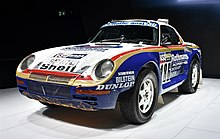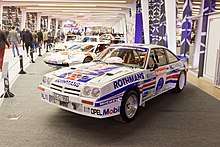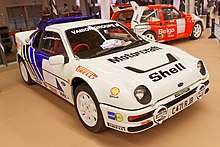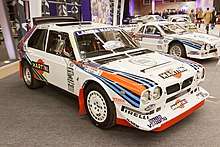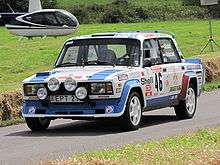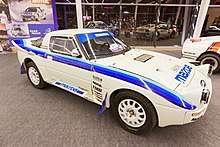Group B
Group B was a set of regulations introduced in 1982 for competition vehicles in sportscar racing and rallying regulated by the Fédération Internationale de l'Automobile (FIA). The Group B regulations fostered some of the fastest, most powerful, and most sophisticated rally cars ever built and is commonly referred to as the golden era of rallying.[1] However, a series of major accidents, some of them fatal, were blamed on their outright speed and lack of crowd control at events. After the death of Henri Toivonen and his co-driver Sergio Cresto in the 1986 Tour de Corse, the FIA disestablished the class, dropped its previous plans to replace it by Group S, and instead replaced it as the top-line formula by Group A. The short-lived Group B era has acquired legendary status among rally fans and automobile enthusiasts in general.
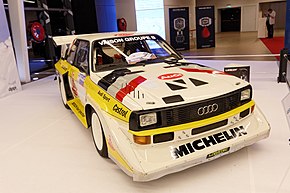
Overview
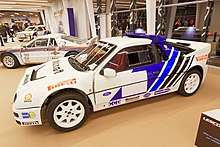
Group B was introduced by the FIA in 1982 as a replacement for both Group 4 (modified grand touring) and Group 5 (touring prototypes) cars.
Group A referred to production-derived vehicles limited in terms of power, weight, allowed technology and overall cost. The base model had to be mass-produced (5000 units/year) and had to have four seats. Group A was aimed at ensuring a large number of privately owned entries in races.
By contrast, Group B had few restrictions on technology, design and the number of cars required for homologation to compete—200, less than other series. Weight was kept as low as possible, high-tech materials were permitted, and there were no restrictions on boost, resulting in the power output of the winning cars increasing from 250 hp in 1981,[2] the year before Group B rules were introduced, to there being at least two cars producing in excess of 500 by 1986, the final year of Group B.[3] In just five years, the power output of rally cars had more than doubled.
The category was aimed at car manufacturers by promising outright competition victories and the subsequent publicity opportunities without the need for an existing production model. There was also a Group C, which had a similarly lax approach to chassis and engine development, but with strict rules on overall weight and maximum fuel load.
Group B was initially a very successful group, with many manufacturers joining the premier World Rally Championship, and increased spectator numbers. But the cost of competing quickly rose and the performance of the cars proved too much resulting in a series of fatal crashes. As a consequence Group B was canceled at the end of 1986 and Group A regulations became the standard for all cars until the advent of World Rally Cars in 1997.
In the following years Group B found a niche in the European Rallycross Championship, with cars such as the MG Metro 6R4 and the Ford RS200 competing as late as 1992. For 1993, the FIA replaced the Group B models with prototypes that had to be based on existing Group A cars, but still followed the spirit of Group B, with low weight, 4WD, high turbo boost pressure and staggering amounts of power.
Group 2 and Group 4
Until 1983 the two main classes of rallying were called Group 2 and Group 4. Major manufacturers competed in Group 4, which required a minimum of 400 examples of a competition car. Notable cars of the era included the Lancia Stratos HF, the Ford Escort RS1800 and the Fiat 131 Abarth.
In 1979 the FISA (then the name of the FIA's motorsport regulatory division) legalized four-wheel drive (4WD). Car companies were not keen on using 4WD as it was generally felt that the extra weight and complexity of 4WD systems would cancel out any performance benefits.
This belief was shattered when Audi launched a competition car in 1980, the Turbocharged and 4WD Quattro. That year a Quattro was used in Portugal's Algarve Rallye. Registered by the Audi Sport Factory Rally Team, IN-NE 3, as an opening (zero) car, it was driven by professional driver Hannu Mikkola. Mikkola's co-driver was Arne Hertz. IN-NE 3's combined time for all stages on this rally was over 30 minutes quicker[4] than that of the winner. While the new car was indeed heavy and cumbersome, its standing starts on gravel and road grip on Special Stages was staggering.
The Quattro was officially entered in the 1980 Jänner-Rallye in Austria and easily won. Audi kept on winning throughout the 1980 and 1981 seasons, although lack of consistent results meant that Ford took the driver's title in 1981 with Ari Vatanen driving a rear-wheel-drive Escort. The team's victory at the 1981 Rallye Sanremo, with the car piloted by Michèle Mouton, was the first time a woman won a World Championship rally. Mouton placed second in the drivers' championship the next year, behind Opel's Walter Röhrl.
Groups N, A and B
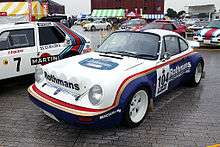
The FISA decided to separate the rally cars into three classes: Group N (production cars), Group A (modified production cars), and Group B (modified sports cars). These groups were introduced in 1982.
Group N and Group A cars were the same cars with different amounts of race preparation allowed (in Group N almost no modifications, in Group A significant modifications). The cars had to have four seats (although the minimum size of the rear seats was small enough that some 2+2 cars could qualify) and be produced in large numbers. This was 5000 cars/year between 1982 and 1991. It later changed to 2500 cars/year if the version being homologated was derived from a mass-market car (25000 cars/year for all versions).
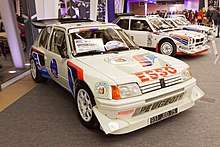
Group B was conceived when the FISA found that numerous car manufacturers wanted to compete in rallying; witnessing the successes of the Stratos and the Quattro, manufacturers felt cars with mid-engine and RWD or 4WD were preferable, however their RWD production models had been gradually replaced by their FWD counterparts, lessening their chance of winning. By reducing the homologation minimum from 400 (in Group 4) to 200, FIA enabled manufacturers to design specialised RWD or 4WD rally cars without the financial commitment of producing their production counterparts in such large numbers.[5]
Group B cars could be two-seaters and the minimum production was 200 cars. Manufacturers were allowed to homologate an evolution each year by producing 20 cars of that evolution. The cars entered in the races were further modified (same modifications allowed as in Group A). Group B could in theory be used to homologate production sports cars, which could not be homologated in Group N or A, because they did not have four seats or were not produced in large enough numbers (e.g. cars like the Ferrari 308, the Porsche 911, etc.). The designation used in the regulations ("Sports Grand Touring Cars") shows this intention.
The major manufacturers, however, used them in a different way: they designed a rally car, of which 20 were produced and designated the evolution model, and then built a limited series of 200 street cars for homologation. (Similar things have been done before in Group 4, for instance the Lancia Stratos.) In some cases these cars were sold at a loss and journalists reviewing them now acknowledge that their development was not quite finished.
In each group there were classes based on engine displacement (with a 1.4 equivalence factor for forced induction engines). Each class had different weight limits, maximum tyre sizes, etc. The most important classes for Group B were the 3000 cc class (2142.8 cc with turbo or supercharger), 960 kg minimum weight (Audi Quattro, Lancia 037) and 2500 cc (1785 cc), 890 kg (Peugeot 205 T16, Lancia Delta S4).
The original Renault 5 Turbo had a 1.4 L engine so it was in the 2000 cc class. The Ferrari 288 GTO and the Porsche 959 were in the 4000 cc (2857 cc), 1100 kg class, which would have probably become the normal class for track racing if Group B had seen much use there. Otherwise they existed for old Group 4 cars which competed until 1985.
Classes in Group B:[6]
| Displacement | Weight | Wheel width (front & back) |
Cars | |
|---|---|---|---|---|
| Naturally-aspirated | Super-, turbo-charged | |||
| 4000 cc | 2857 cc | 1100 kg | 24" | Ferrari 288 GTO, Porsche 959 |
| 3000 cc | 2142.8 cc | 960 kg | 22" | Audi Quattro, Lancia 037, MG Metro 6R4, Ford RS200 |
| 2500 cc | 1785 cc | 890 kg | 22" | Peugeot 205 T16, Lancia Delta S4 |
| 2000 cc | 1428 cc | 820 kg | 20" | Renault 5 Turbo |
Audi was in the 3000 cc class because the displacement of the street car happened to be in that class, and as a car derived from the street version, it would have been difficult to reach the minimum weight needed. For the 037 Lancia decided that the lower class might be too light and consequently too fragile for gravel rallies, and they happened to have a good 2000 cc engine.
When these rules were decided it was felt that these displacement restrictions would be enough to control power, but in the early and mid-1980s engineers learnt how to extract extraordinary amounts of power from turbo engines (the same thing was happening in F1). Nowadays the power of turbo engines is limited by mandating a restrictor in the intake (in World Rally Car, Group A and Group N).
1983–1985
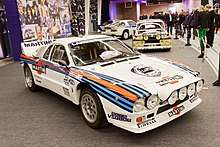
Although the Audi Quattro was still in essence a Group 4 car, it carried Hannu Mikkola to the driver's title in 1983. Lancia had designed a new car to Group B specifications, but the Lancia 037 still had rear wheel drive and was thus less consistent than the Audi over different surfaces (generally the Lancia had the upper hand on tarmac, with the Audi remaining superior on looser surfaces such as snow and gravel). Nevertheless, the 037 performed well enough for Lancia to capture the manufacturers title, which was generally considered more prestigious at the time, with a rally to spare. In fact, so low was Lancia's regard for the Drivers Championship, they did not enter a single car into the season finale RAC Rally, despite the fact that driver Walter Röhrl was still in the hunt for the title.
The low homologation requirements quickly attracted manufacturers to Group B. Opel replaced their production-derived Ascona with the Group B Manta 400, and Toyota built a new car based on their Celica. Like the Lancia 037 both cars were rear wheel drive, but, while successful in national rallying in various countries, they were less so at World Championship level, although Toyota won the 1983 Ivory Coast Rally after hiring Swedish desert driving specialist, the late Björn Waldegård.
In 1984, Audi's Stig Blomqvist beat Lancia to the driver's title, although the victory was bittersweet: Midway through the year Peugeot had joined the rallying scene with its Group B 205 T16. The T16 also had four wheel drive and was smaller and lighter than the Audi Quattro. At the wheel was the 1981 driver's champion Ari Vatanen, with future Ferrari Formula One team manager and FIA President Jean Todt overseeing the operation. A crash prevented the T16 from winning its first rally but the writing was on the wall for Audi.
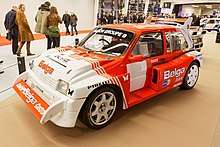
Despite massive revisions to the Quattro, including a shorter wheelbase, Peugeot dominated the 1985 season. Although not without mishap: Vatanen plunged off the road in Argentina and was gravely injured when his seat mountings broke in the ensuing crash. Timo Salonen won the 1985 champion title with 5 wins.
Although the crash was a sign that Group B cars had already become dangerously quick (despite Vatanen having a consistent record of crashing out while leading), several new Group B cars entered the rallying world in 1985:
- Late in the year, Lancia replaced their outclassed 037 with the Delta S4, which featured both a turbocharger and a supercharger for optimum power output.
- Ford returned after several years away with the Ford RS200 and the Ford Sierra RS Cosworth (though the latter went on to compete in Group A).
- Citroën developed and entered the BX 4TC, which ultimately was too heavy and cumbersome to be successful.
- Rover created the distinctive Metro 6R4, which featured boxy bodywork and a large spoiler mounted on the front of the car.
1986
For the 1986 season, defending champion Timo Salonen had the new Evolution 2 version of Peugeot's 205 T16 with ex Toyota driver, Juha Kankkunen. Audi's new Sport Quattro S1 boasted over 600 hp (450 kW) and a huge snowplough-like front end. Lancia's Delta S4 would be in the hands of the Finnish prodigy Henri Toivonen and Markku Alén, and Ford was ready with its high tech RS200 with Stig Blomqvist and Kalle Grundel.
On the "Lagoa Azul" stage of the Portuguese Rally near Sintra, Portuguese national champion Joaquim Santos crested a rise, turning to his right to avoid a small group of spectators. This caused him to lose control of his RS200. The car veered to the right and slid off the road into the spectators. Thirty-one people were injured and three were killed. All the top teams immediately pulled out of the rally and Group B was placed in jeopardy.
Disaster struck again in early May at the Tour de Corse. Lancia's Toivonen was the championship favorite, and once the rally got underway he was the pace setter. Seven kilometres into the 18th stage, Toivonen's S4 flew off the unguarded edge of a tightening left hand bend and plunged down a steep wooded hillside. The car landed inverted with the fuel tanks ruptured by the impact. The combination of red hot turbocharger, Kevlar bodywork, and ruptured fuel tank ignited the car and set fire to the dry undergrowth. Toivonen and co-driver Sergio Cresto died in their seats.[7][8][9] With no witnesses to the accident it was impossible to determine what caused the crash other than Toivonen had left the road at high speed. Some cite Toivonen's ill health at the time (he reportedly was suffering from flu)[10]; others suggest mechanical failure, or simply the difficulty of driving the car, although Toivonen had a career full of crashing out while leading rallies. Up until that stage he was taking stage win after stage win and leading the rally by a large margin, with no other driver challenging him.[10]
The crash came a year after Lancia driver Attilio Bettega had crashed and died in his 037. While that fatality was largely blamed on the unforgiving Corsican scenery (and bad luck, as his co-driver, Maurizio Perissinot was uninjured), Toivonen and Cresto's deaths, combined with the Portugal tragedy and televised accident of F1 driver Marc Surer in another RS200 which killed co-driver Michel Wyder, compelled the FIA ban Group B cars immediately for 1987. Audi decided to quit Group B entirely after the Corsica rally.
The final days of Group B would also be controversial. The Peugeots were disqualified from the Rally Sanremo by the Italian scrutineers as the 'skirts' around the bottom of the car were deemed to be illegal. Peugeot immediately accused the Italians of favouring Lancia. Their case was strengthened at the next event, the RAC Rally, when the British scrutineers passed the Peugeots as legal in identical trim. FISA annulled the result of the Sanremo Rally eleven days after the final round in the United States. As a result, the championship title was passed from Lancia's Markku Alén to Peugeot's Juha Kankkunen. Timo Salonen had won another two rallies during the 1986 season and became the most successful group B era driver with a total of seven wins.
Disposition


Although 1987 saw the end of the Group B cars on the world stage they did not disappear from motorsport. Peugeot adapted their T16 to run in the Dakar Rally. Ari Vatanen won the event in 1987, 1989 and 1990. Improved Peugeot and Audi cars also competed in the Pikes Peak Hillclimb in Colorado. Walter Röhrl's S1 Rally car won the Pikes Peak International Hill Climb in 1987 and set a new record at the time. Audi used their Group B experience to develop a production based racing car for the Trans-Am and IMSA GTO series in 1988 and 1989 respectively. Ford sold off their RS200s to private buyers, with many being used in European Rallycross events from the beginning of 1987 till the end of 1992. The Metro 6R4 also became a frequent sight in Rallycross and the car was also entered in British and Irish national championship events. Porsche's 959 never entered a World Rally event, although it did compete in the Middle East championship and won the Paris-Dakar Rally. The 961 prototype won the GTX class at the 24 Hours of Le Mans 1986 race but crashed and caught fire in 1987. The Ferrari 288 GTO was built and sold the minimum requirement of cars to the public, however it never saw action in its category. The WSPC grids it was intended for was filled up by a batch of Group C cars, but it saw limited use in an IMSA GTO race in 1989.
Group S
As well as the cancellation of Group B, the tragedies of 1986 also brought about the scrapping of Group B's proposed replacement: Group S.
Group S rules would have limited car engine power to 300 hp (225 kW). To encourage innovative designs, ten examples of a car would have been required for homologation, rather than the 200 required for Group B. By the time of its cancellation, at least four Group S prototypes had been built: The Lancia ECV, the Toyota MR2-based 222D, the Opel Kadett Rallye 4x4 (a.k.a. Vauxhall Astra 4S) and the Lada Samara S-proto, and new cars were also planned by both Audi (the 002 Quattro) and Ford (a Group S development of the RS200). The cancellation of Group S angered many rally insiders who considered the new specification to be safer than Group B and more exciting than Group A.
The Group S concept was revived by the FIA in 1997 as the World Rally Car specification which, as of 2018, is still in use. WRC cars are limited to 380 hp (280 kW) and require 20 examples of a model but, unlike Group S, are required to share certain parts with production cars.
Legacy
The era of Group B is often considered one of the most competitive and compelling periods in rallying.[11] The combination of lightweight chassis, sophisticated aerodynamics and massive amounts of horsepower resulted in the development of a class of cars whose performance has not yet been surpassed within their category, even three decades later.[12] In reference to their dubious safety record, however, the class has also earned an unsavory nickname among enthusiasts: "Killer B's".[12] In contrast to this, many enthusiasts refer the Group B era as the Golden Age of Rallying.[13][14][15][16]
Cars
Group B
NB: cars that were issued with Group B homologation certificate but were never built as a Group B racer are listed.
| Indicates pure-Group B cars, cars specifically designed to compete in the class | |
| Indicates semi-homlogated cars, cars that was an evolution of existing production model especially to pass homlogations | |
| Indicates those who used mainstream high-volume models for homlogation | |
| Indicates transferred from Group 4 homlogation | |
| Indicates Group A cars that have been retroactively been given Group B homologation for failing to meet homologation guidelines | |
| Indicates cars that was rehomologated as a Group A car. | |
| Indicates cars which received post-ban homlogation, effective from 1 January 1987 | |
| Indicates cars that never received homlogation, therefore was extant as a prototype |
| Car | Class | Homologation n° | Date of homologation | Note | Source |
|---|---|---|---|---|---|
| Alfa Romeo GTV 2000 Turbodelta | B/12 | B-238 | 1 March 1983 | [17] | |
| Alfa Romeo Alfasud Sprint 6C | Prototype | ||||
| Alfa Romeo SZ | B/12 | B-297 | 1 November 1992 | [18] | |
| Alpine A310 V6 | B/12 | B-204 | 1 February 1982 | [19] | |
| Alpine A610 | B/12 | B-299 | 1 April 1993 | [20] | |
| Audi Quattro A1 | B/12 | B-229 | 1 January 1983 | [21] | |
| Audi 80 Quattro A2 | B/12 | B-231 | 1 January 1983 | [nb 1] | [21] |
| Audi Quattro A1 | B/12 | B-242 | 1 May 1983 | [nb 2] | [21] |
| Audi Quattro A2 | B/12 | B-243 | 1 May 1983 | [21] | |
| Audi Sport Quattro S1 | B/12 | B-243 | 1 May 1984 | [21] | |
| Audi Sport Quattro E2 | B/12 | B-264 | 1 July 1985 | [22] | |
| BMW M1 | B/12 | B-240 | 1 March 1983 | [23] | |
| Citroën BX 4TC | B/12 | B-279 | 1 October 1986 | [24] | |
| Citroën Visa Trophée | B/9 | B-201 | 1 January 1982 | [24] | |
| Citroën Visa Chrono II | B/10 | B-219 | 1 October 1982 | [24] | |
| Citroën Visa 1000 Pistes | B/10 | B-258 | 1 March 1984 | [24] | |
| Daihatsu Charade 926 Turbo | B/9 | B-268 | 1 January 1985 | [25] | |
| Daihatsu Charade DeTomaso 926R | Under 1300cc | Prototype | [25] | ||
| Ferrari 308 GTB Michelotto | B/12 | B-220 | 1 October 1982 | [26] | |
| Ferrari 308 GTB Michelotto | B/12 | B-236 | 1 January 1983 | [26] | |
| Ferrari 308 Quattrovalvole | B/12 | B-241 | 1 April 1983 | [26] | |
| Ferrari 288 GTO | B/12 | B-273 | 1 June 1985 | [26] | |
| Ferrari 288 GTO Evoluzione | Prototype | [nb 3] | [26] | ||
| Ferrari F40 | B/12 | B-293 | 1 December 1989 | [27] | |
| Ford RS200 | B/12 | B-280 | 1 February 1986 | [28] | |
| Ford Escort RS 1700T | Prototype | [nb 4] | [28] | ||
| Ford Escort RS Turbo | B/12 | B-270 | 1 April 1985 | [nb 5] | |
| Ford Sierra RS Cosworth | B/12 | B-286 | 1 August 1986 | [nb 6] | |
| FSO Polonez 2500 Racing | Prototype | 1 April 1985 | |||
| FSO Polonez 2000 Rally | B/11 | B-261 | 1 April 1984 | ||
| FSO Polonez 2000 Turbo | Under 2000cc | Prototype | |||
| Giocattolo Group B | Prototype | ||||
| Jaguar XJS | B/12 | B-292 | 1 February 1988 | [29] | |
| Lada 2105 VFTS | B/10 | B-222 | 1 October 1982 | [30] | |
| Lada Samara EVA | Prototype | [30] | |||
| Lamborghini Countach 5000QV | B/12 | B-291 | 1 January 1988 | [31] | |
| Lancia Rally 037 | B/12 | B-210 | 1 April 1982 | [32] | |
| Lancia Delta S4 | B/12 | B-276 | 1 November 1985 | [32] | |
| Mazda RX-7 | B/12 | B-255 | 1 February 1984 | [33] | |
| Mercedes-Benz 190E Cosworth | Prototype | [nb 7] | [34] | ||
| MG Metro 6R4 | B/12 | B-277 | 1 November 1985 | [35] | |
| Mitsubishi Lancer 2000 Turbo | B/12 | B-230 | 1 January 1983 | [36] | |
| Mitsubishi Starion 4WD | Prototype | [nb 8] | |||
| Moskvitch-Aleko 2141-KR | Prototype | [37] | |||
| Nissan 240RS | B/12 | B-233 | 1 January 1983 | [38] | |
| Opel Ascona 400 | B/12 | B-221 | 1 November 1982 | ||
| Opel Manta 400 | B/12 | B-237 | 1 March 1983 | [39] | |
| Peugeot 205 Turbo 16 | B/12 | B-262 | 1 April 1984 | [40] | |
| Peugeot 305 V6 | Prototype | [nb 9] | |||
| Peugeot 504 Turbo Injection | B/12 | B-252 | 1 November 1983 | ||
| Peugeot 504 Pickup | B/11 | B-228 | 1 December 1982 | [40] | |
| Porsche 924 Carrera GT | B/12 | B-203 | 1 January 1982 | [41] | |
| Porsche 911 SC RS | B/12 | B-207 | 1 March 1982 | [41] | |
| Porsche 911 Turbo | B/12 | B-208 | 1 January 1982 | [41] | |
| Porsche 928S | B/12 | B-209 | 1 January 1982 | [41] | |
| Porsche 911 Carrera | B/12 | B-282 | 1 June 1986 | [41] | |
| Porsche 911 Carrera 2 | B/12 | B-294 | 1 September 1990 | [42] | |
| Porsche 911 Carrera 4 | B/12 | B-295 | 1 September 1990 | [43] | |
| Porsche 911 Carrera RS | B/12 | B-296 | 1 March 1992 | [44] | |
| Porsche 911 Turbo | B/12 | B-298 | 1 April 1993 | [45] | |
| Porsche 928S | B/12 | B-283 | 1 June 1986 | [41] | |
| Porsche 944 Turbo | B/12 | B-284 | 1 June 1986 | [41] | |
| Porsche 959 | Prototype | [41] | |||
| Porsche 961 | Prototype | ||||
| Premier 118NE | B/9 | B-290 | 1 November 1988 | [46] | |
| Renault 5 Turbo "Cévennes" | B/11 | B-205 | 1 February 1982 | [47] | |
| Renault 5 Turbo "Tour de Corse" | B/11 | B-234 | 1 January 1983 | ||
| Renault 5 Maxi Turbo | B/12 | B-267 | 1 December 1984 | ||
| Seat Fura Crono 1.6 | B/10 | B-244 | 1 May 1983 | ||
| Škoda 130 LR | B/9 | B-269 | 1 January 1985 | [48] | |
| Subaru MP-1 Utility | B/11 | B-259 | 1 March 1984 | [49] | |
| Subaru XT 4WD Turbo | B/12 | B-275 | 1 October 1985 | [50] | |
| Talbot Sunbeam Lotus | B/12 | B-227 | 1 December 1982 | [51] | |
| Talbot Horizon | Prototype | [nb 2] | [51] | ||
| Talbot Samba Rallye | B/9 | B-232 | 1 January 1983 | [51] | |
| Toyota Celica Twin-Cam Turbo | B/12 | B-239 | 1 March 1983 | [52] |
Group S
- Audi Sport Quattro RS 002[21]
- Ford RS200
- Lada Samara S-proto
- Lancia ECV
- Mazda RX7S [53]
- Opel Kadett Rallye 4x4/Vauxhall Astra 4S
- Peugeot 405 T16 GR
- Škoda 130LR Evolution
- Toyota 222D (based upon MR2)
Notable drivers
References
- Top Gear website: The corner that killed Group B Archived 7 June 2013 at the Wayback Machine
- Chrysler Sunbeam Ti_and_Sunbeam_Lotus
- Lancia Delta S4
- Audi Quattro – Graham Robson. Google Books (15 June 2008). Retrieved 2 May 2012.
- Mad For It, Mike Goodbun, Classic Cars, December 2006
- FIA Regulations, Appendix J 1986, Art. 256 – Specific regulations for Sports Cars (Gr. B): http://www.fia.com/resources/documents/991499716__Hist_App_J_86_Art_256_a.pdf Archived 17 October 2006 at the Wayback Machine
- "Henri Toivonen Biography". www.thruxton.f9.co.uk. Archived from the original on 31 December 2006. Retrieved 14 January 2018.
- "The corner that killed Group B". topgear.com. 19 May 2013. Archived from the original on 27 October 2017. Retrieved 14 January 2018.
- Oagana, Alex (22 November 2010). "Group B Rally Cars: The Killer B's". autoevolution.com. Archived from the original on 14 January 2018. Retrieved 14 January 2018.
- "Toivonen e Cresto: appuntamento col destino
- Oagana, Alex (22 November 2010). "Group B Rally Cars: The Killer B's". autoevolution.com. Archived from the original on 24 March 2013. Retrieved 25 February 2013.
- Lieberman, Jonny. "Crowning The King Of 1986: Audi Quattro S1 vs Ford RS200 vs Lancia Delta S4 vs Peugeot 205 TI6". jalopnik.com. Archived from the original on 8 March 2013. Retrieved 25 February 2013.
- "Embrace the Golden Age of Rallying With This Peugeot 205 T16 Group B Homologation". GTPlanet. 8 February 2018. Retrieved 30 December 2019.
- "Own Seven Different "Killer Bees" From the Golden Age of Rallying". Cool Material. 15 June 2017. Retrieved 30 December 2019.
- "The anatomy of a Group B rally car - history and tech of rallying's golden era". Evo. Retrieved 30 December 2019.
- DCXMag.com (30 November 2016). "The Golden Age of Rally". Die Cast X. Retrieved 30 December 2019.
- https://rallygroupbshrine.org/wp-content/uploads/2017/04/alfa_romeo_turbodelta_number_238_group_b.pdf
- https://historicdb.fia.com/car/ferrari-f40-2936
- https://rallygroupbshrine.org/the-group-b-cars/rally-cars/renault-alpine-a310-v6/
- http://historicdb.fia.com/car/renault-alpine-a610-turbo-2975
- Audi Archived 6 August 2012 at the Wayback Machine. Group B Rally. Retrieved 2 May 2012.
- https://rallygroupbshrine.org/the-group-b-cars/rally-cars/opel-ascona-b-400/
- BMW Archived 6 July 2012 at the Wayback Machine. Group B Rally. Retrieved 2 May 2012.
- Citroën Archived 7 July 2012 at the Wayback Machine. Group B Rally (1 January 1982). Retrieved 2 May 2012.
- Daihatsu Archived 15 June 2012 at the Wayback Machine. Group B Rally. Retrieved 2 May 2012.
- Ferrari Archived 15 June 2012 at the Wayback Machine. Group B Rally. Retrieved 2 May 2012.
- https://historicdb.fia.com/car/ferrari-f40-2936
- Ford Archived 7 July 2012 at the Wayback Machine. Group B Rally (1 January 1983). Retrieved 2 May 2012.
- http://historicdb.fia.com/car/jaguar-xjs-1
- Lada Archived 7 July 2012 at the Wayback Machine. Group B Rally. Retrieved 2 May 2012.
- http://historicdb.fia.com/car/lamborghini-countach-quattrovalvole
- Lancia Archived 15 June 2012 at the Wayback Machine. Group B Rally (4 January 1982). Retrieved 2 May 2012.
- Mazda Archived 7 July 2012 at the Wayback Machine. Group B Rally. Retrieved 2 May 2012.
- Mercedes Archived 7 July 2012 at the Wayback Machine. Group B Rally. Retrieved 2 May 2012.
- Austin / MG / Rover Archived 6 July 2012 at the Wayback Machine. Group B Rally. Retrieved 2 May 2012.
- Mitsubishi Archived 7 July 2012 at the Wayback Machine. Group B Rally. Retrieved 2 May 2012.
- Moskvich Archived 15 June 2012 at the Wayback Machine. Group B Rally. Retrieved 2 May 2012.
- Nissan Archived 15 August 2012 at the Wayback Machine. Group B Rally. Retrieved 2 May 2012.
- Opel Archived 15 August 2012 at the Wayback Machine. Group B Rally (1 May 1983). Retrieved 2 May 2012.
- Peugeot Archived 15 June 2012 at the Wayback Machine. Group B Rally (4 January 1984). Retrieved 2 May 2012.
- Porsche Archived 21 January 2010 at the Wayback Machine. Group B Rally. Retrieved 2 May 2012.
- http://historicdb.fia.com/car/porsche-911-carrera-2
- http://historicdb.fia.com/car/porsche-911-carrera-4
- http://historicdb.fia.com/car/porsche-911-carrera-rs
- http://historicdb.fia.com/car/porsche-911-turbo-2-3299
- http://historicdb.fia.com/car/premier-118-ne
- https://rallygroupbshrine.org/the-group-b-cars/rally-cars/renault-5-turbo/
- Skoda Archived 7 July 2012 at the Wayback Machine. Group B Rally. Retrieved 2 May 2012.
- https://rallygroupbshrine.org/the-group-b-cars/rally-cars/subaru-mp-1-utility/
- "TECHNICAL REGULATIONS FOR CARS COMPETING IN INTERNATIONAL HISTORIC EVENTS" (PDF). Federation Internationale de l'Automobile. Archived (PDF) from the original on 5 July 2010. Retrieved 28 April 2010.
- Talbot Archived 6 July 2012 at the Wayback Machine. Group B Rally. Retrieved 2 May 2012.
- Toyota Archived 7 July 2012 at the Wayback Machine. Group B Rally. Retrieved 2 May 2012.
- "Mazda RX7S Group B Prototype". Rally Group B Shrine. 22 December 2016. Retrieved 2 August 2020.
- Re-homlogated as Group A, homlogation number 5156
- 2145cc engine upgrade
- car built to gr. B regulations but not homologated; project abandoned in favor of F40
- car built to gr. B regulations but not homologated; project abandoned in favor of RS200
- Re-homlogated as Group A, homlogation number 5272
- Re-homlogated as Group A, homlogation number 5323
- Abandoned once the Audi Quattro became known.
- not homologated before Group B ended, ran as prototype
- car built to gr. B regulations but not homologated; project abandoned in favor of 205 T16

